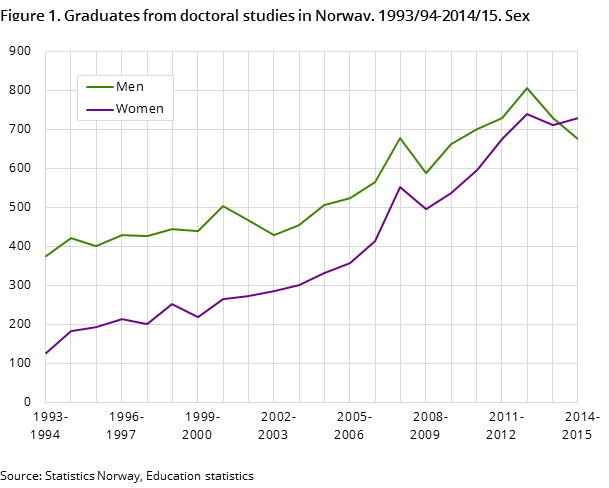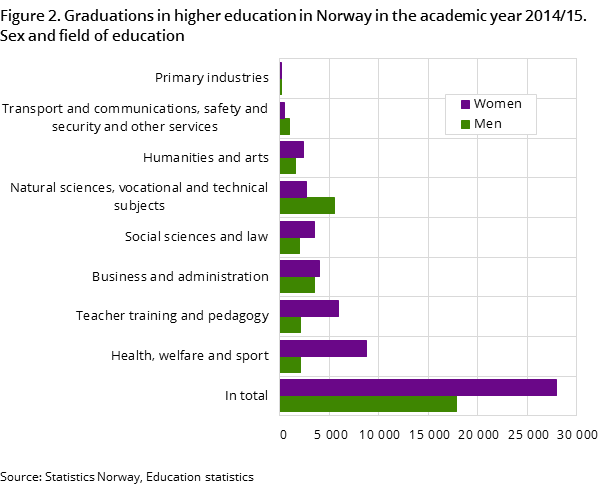Content
Published:
This is an archived release.
More women than men graduated at doctorate level
The trend for a number of years has been for more women than men to graduate at both undergraduate and graduate level. For the first time in 2014/15, more women than men also graduated at doctorate level.
| Share | Share | Share | |
|---|---|---|---|
| 2010-2011 | 2013-2014 | 2014-2015 | |
| 1Ordinary students are those registered per 1 October yyyy and are not in continuing education. | |||
| Graduations | |||
| Total | 100.0 | 100.0 | 100.0 |
| Universities | 44.6 | 43.2 | 42.8 |
| Specialised university institutions | 12.3 | 11.1 | 10.6 |
| State university colleges | 36.2 | 37.3 | 37.2 |
| Military university colleges | 0.5 | 0.5 | 0.4 |
| Other university colleges | 6.4 | 8.0 | 8.9 |
| Males | 39.0 | 38.9 | 39.0 |
| Females | 61.0 | 61.1 | 61.0 |
| Immigrants | 8.5 | 10.4 | 10.8 |
| Norwegian-born to immigrant parents | 1.3 | 1.9 | 2.0 |
| Other population | 90.2 | 87.7 | 87.2 |
| Credit points production of ordinary full-time tertiary1 | |||
| Total | 100.0 | 100.0 | 100.0 |
| Students with completed 0 credit points | 9.8 | 8.4 | 8.4 |
| Students with completed 1-29 credit points | 9.3 | 7.9 | 8.1 |
| Students with completed 30-59 credit points | 28.8 | 28.8 | 28.2 |
| Students with completed 60 credit points and more | 52.1 | 54.9 | 55.3 |


A total of 45 800 graduations took place in Norwegian universities and colleges during the academic year 2014/15. Women accounted for 61 per cent of the graduations.
Women accounted for 63 per cent of the 31 100 graduations at undergraduate level, and 57 per cent of the 13 300 graduations at graduate level. At doctorate level, 52 per cent of the graduations were by women.
Figures for the calendar year 2015 from the Nordic Institute for Studies in Innovation, Research and Education (NIFU) indicate that the female proportion will continue to rise in the next academic year.
More degrees are awarded to students in the younger age groups
As the number of graduations from universities and colleges continue to rise, even more degrees are being awarded to students in the younger age groups.
The number of university and college graduations increased by 800 in 2014/15 compared with the year before. There was an increase of 1 200 graduations in the age group 19–34 years, and a decrease of 400 in the age group 35 years and older. This trend is equally common at undergraduate and graduate level. At undergraduate level, 670 more degrees were awarded in 2014/15 than the year before. In the age group 19–34, there was an increase of 850 graduations at this level, but also 180 fewer graduations in the age group 35 years and older. At graduate level, there was an increase of 150 graduations from the year before, with about 450 more graduations in the age group 19–34 years, but also 300 fewer in the age group 35 years and older.
More than half of full-time students achieved 60 credits
Sixty credits normally correspond to one year of full-time study. More than half of the 182 000 full-time students attained 60 credits in the academic year 2014/15. About 15 500 of the full-time students did not get any credits.
An average of 52 credits was attained by the 166 500 full-time students who achieved credits. The average for all full-time students was 48 credits.
Contact
-
Beate Bartsch
E-mail: beate.bartsch@ssb.no
tel.: (+47) 40 81 14 96
-
Nawid Fazli
E-mail: nawid.fazli@ssb.no
tel.: (+47) 97 09 77 18
-
Geir Nygård
E-mail: geir.nygard@ssb.no
tel.: (+47) 48 15 13 44
